Ever opened an old can of Danish oil and wondered, ‘Has this gone bad?’ Dive in as we unravel the mystery behind its shelf life!
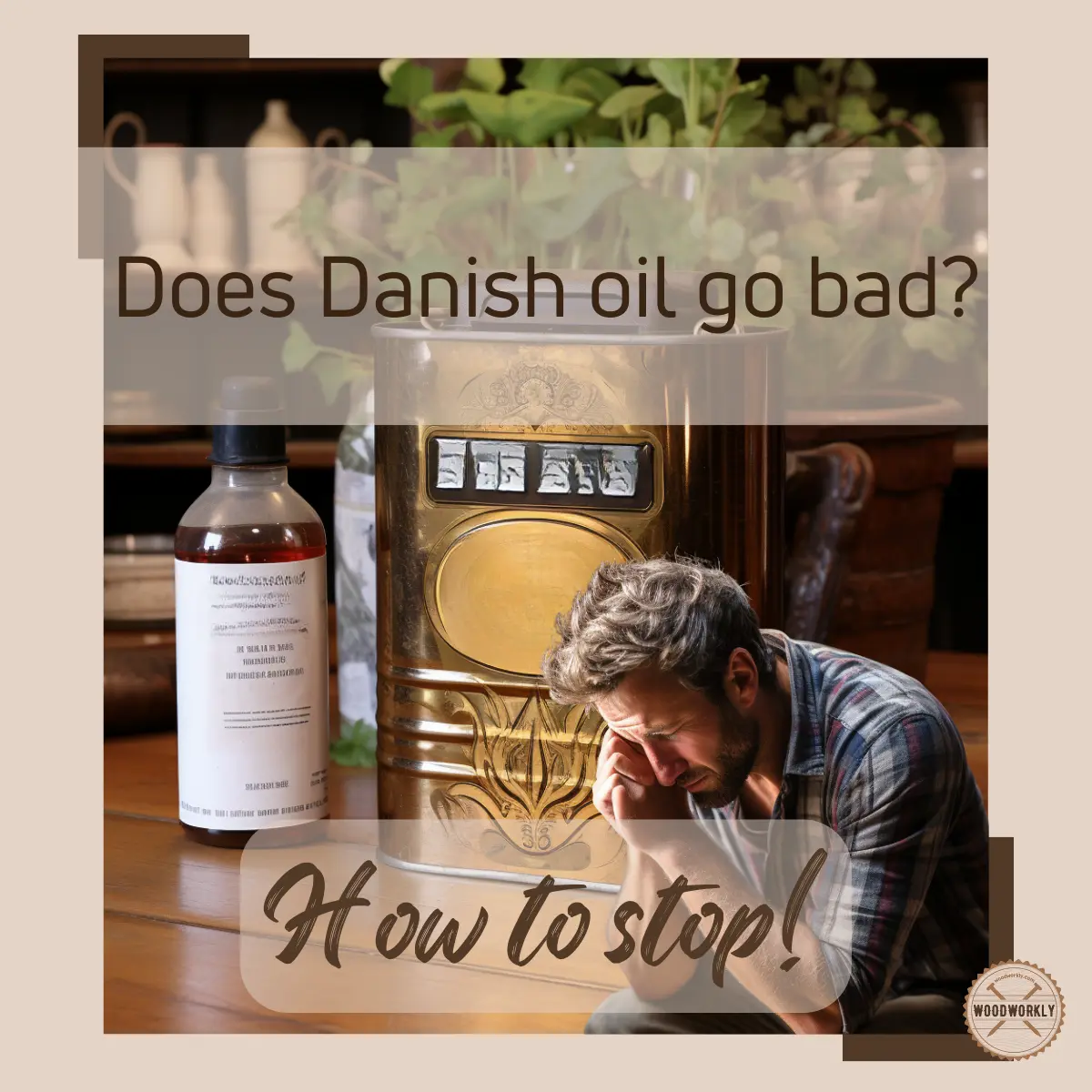
Danish oil, a renowned wood finisher, has been my companion in many projects, shielding wood from the ravages of the environment.
I fondly recall using it on a pristine dining table I crafted during my early woodworking days.
However, a subsequent experience with the same can of oil left me baffled by a less-than-perfect finish on a cabinet.
Dive in as I explore and uncover the mystery behind why my Danish oil went awry, with insights from industry experts.
So, let’s find out, Does Danish oil go bad?
Yes, Danish oil can go bad, especially if exposed to air or stored improperly. An opened can lasts about 1-2 years, while an unopened can has a longer shelf life when stored in a cool, dark place. Signs of spoilage include a rancid smell and a thickened consistency.
As long as Danish oil isn’t exposed to air, it can live so much longer after the best years.

In his article, I’ll deeply explore, does Danish oil go bad, how can you tell if Danish oil is bad, how long does Danish oil last on wood, does Danish oil cause mold, and other problems that occur when Danish oil goes bad.
Furthermore, I’ll answer some frequently asked questions as well.
So, Let’s jump in!
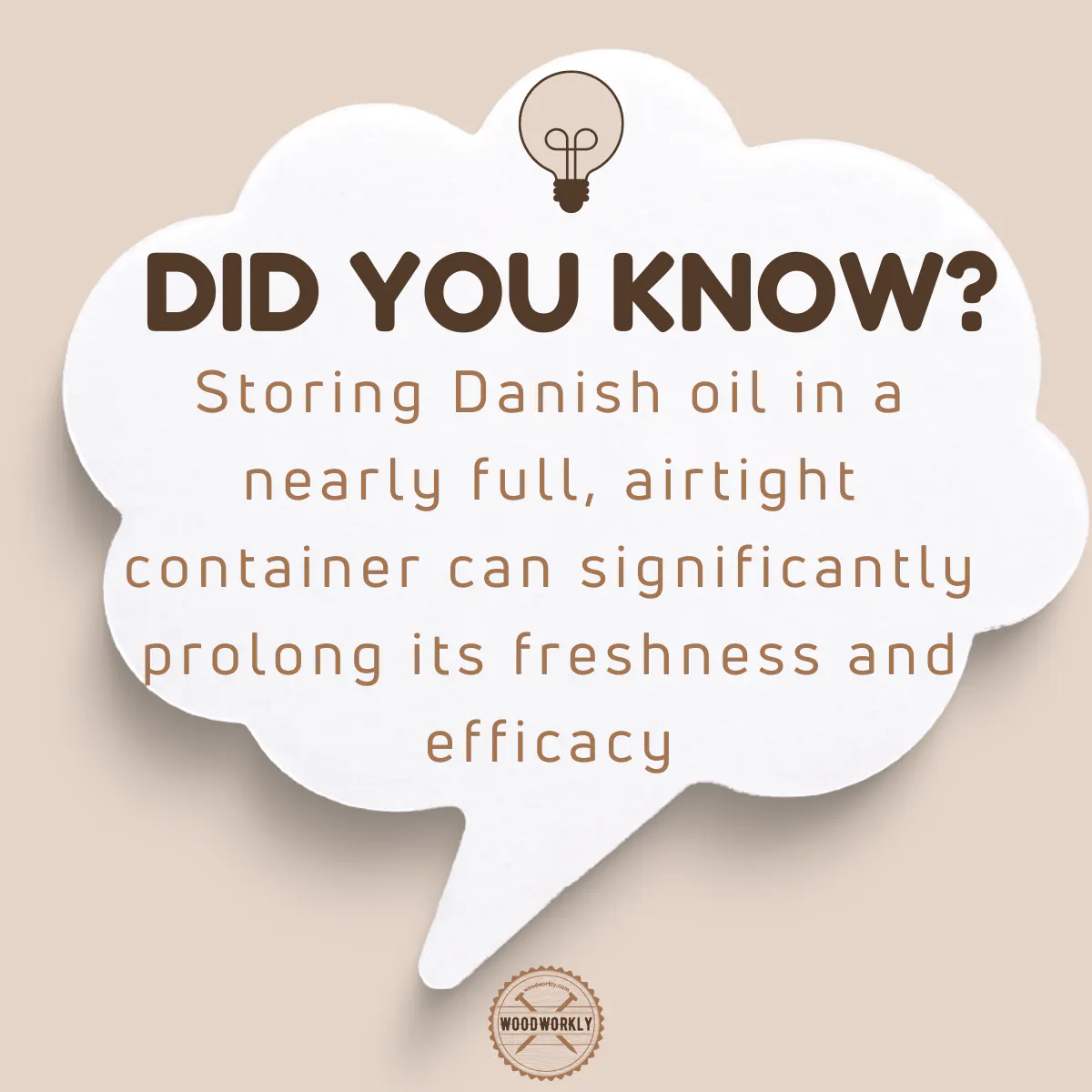
Can Danish Oil Go Bad?
Yes, like many wood finishes, Danish oil can and does go bad, especially if not stored correctly.
But let’s dive deeper into this topic, understand the reasons, signs, and preventive measures, peppered with a few personal anecdotes to make it more relatable.
The Composition and Shelf Life
Danish oil, as some might know, is an eclectic blend of linseed oil, tung oil, and mineral spirit.
Depending on the manufacturer, the exact mix can vary.
This blend has given many a woodworker, including myself, impressive results on projects due to its water resistance, quick drying time, and ability to prime wood.
In one of my early woodworking projects, I remember being excited about using Danish oil.
The shine and finish it provided were unparalleled. However, a year later, when I returned to the same can for a new project, I was met with disappointment.
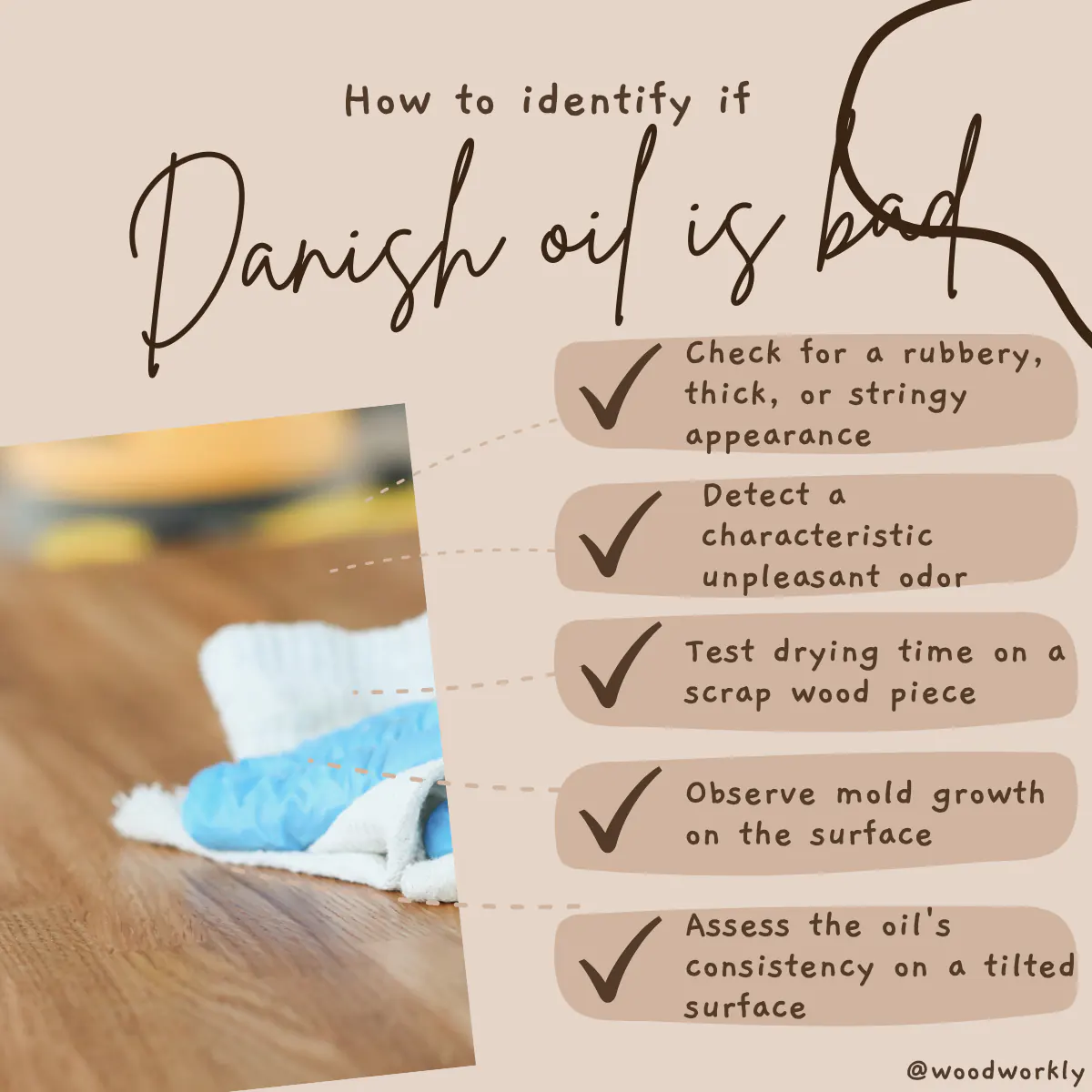
Proper Storage is Key
Danish oil’s life expectancy is typically between two to three years when stored right.
And by ‘right’, I mean in a tightly sealed container, preferably full or nearly so, and kept in a cool, dry place.
You’d think this sounds simple, right? But many of us, including yours truly, have learned the hard way.
The time I mentioned earlier, when I went back to my can of Danish oil, I found it had thickened and turned rubbery because I hadn’t sealed it tightly.
Why does this happen? The reason is simple. When exposed to air, Danish oil begins to polymerize and harden, losing its strength.
If moisture gets in or if the oil mixes with other chemicals, its shelf life gets reduced further. A similar fate awaits tung oil, by the way.
Signs That Danish Oil Has Gone Bad
If you’ve been woodworking for as long as I have, you get a sixth sense for these things. But for those still developing that intuition, here are some signs:
- Visual Inspection: Bad Danish oil tends to become thick, rubbery, and might separate into different layers. It’s a sad sight, especially if you were hoping to use it.
- The Sniff Test: Just like milk, if it smells off, it probably is. Danish oil develops an unpleasant, characteristic odor when it goes bad.
- The Dry Test: Here’s a trick I learned from a fellow woodworker. Take a bit of the oil and apply it to a scrap wood piece. If it dries well, you’re good to go. If it remains sticky or doesn’t dry even after 12-24 hours, it’s time to bid that can goodbye.
A Personal Word of Caution on Mold
One thing I’ve observed, which the article rightly pointed out, is that old, degraded Danish oil can be a food source for mold.
Once, I applied some old Danish oil to a garden bench. Within weeks, mold started showing up. It was heart-wrenching to see the wood get affected.
To prevent such incidents, regular cleaning and placing your furniture in sunlight can be beneficial.
Sunlight naturally fights off mold, and a regular clean keeps contaminants at bay.
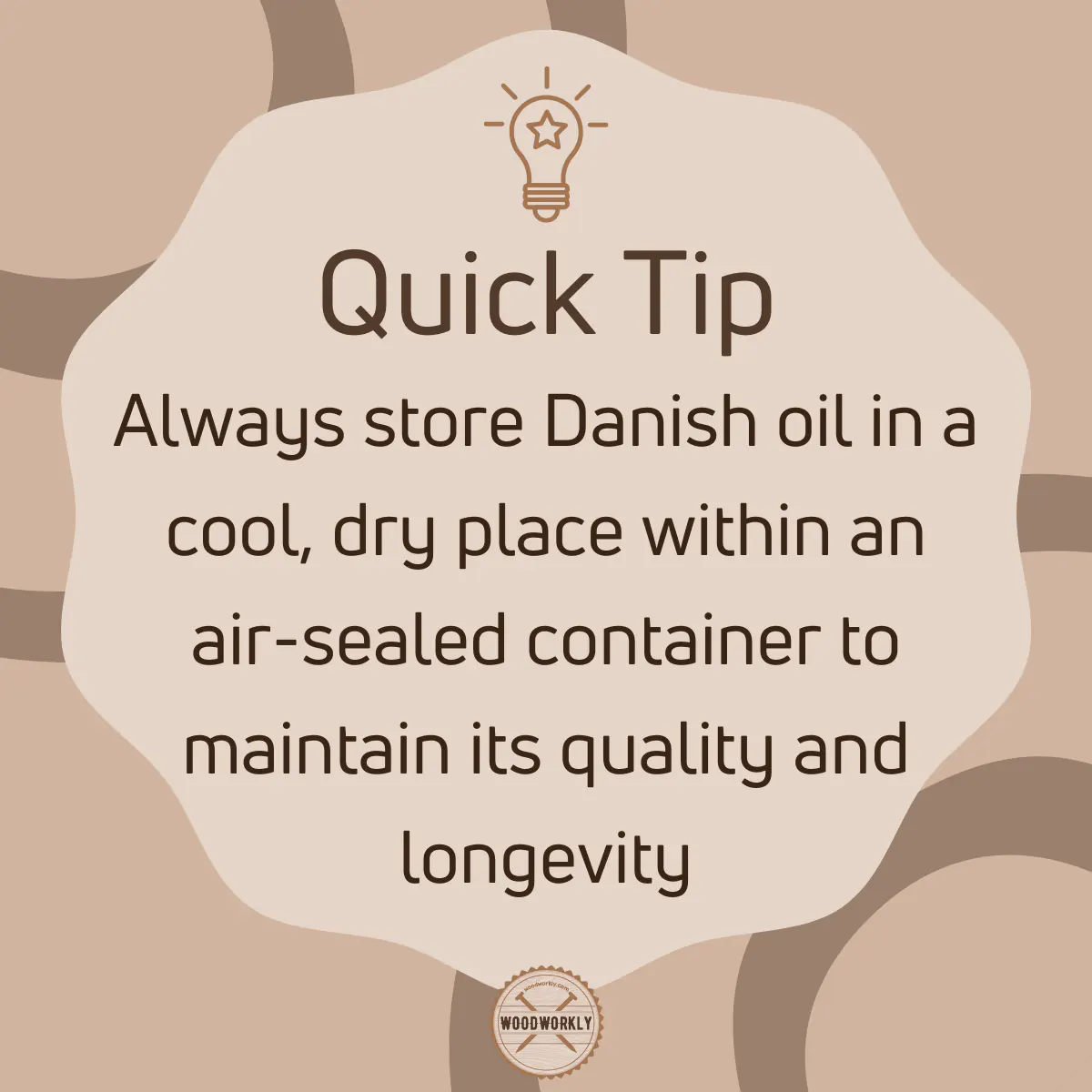
Does Danish Oil Get Old?
Yes, Danish oil gets old within 2 to 3 years or less if it hasn’t been stored properly. As soon as Danish oil gets exposed to air, it will loosen its strength.
Danish oil is popular among woodworkers because of its excellent properties like waterproofing, fast drying, and user-friendliness and it has so many advantages.
Same time it has a good shelf life as well.
With proper care and Danish oil able to live even more than decades.
Make sure to store Danish oil in an airtight container that is properly sealed. Place the Danish oil container in a cool, dry place with zero contact with the outside air.
Better if you can store Danish oil in a full or nearly full container because the moisture that is trapped inside the Danish oil container will react with the Danish oil catalyst and lose its strength and reduce the shelf life.
Therefore, it is important to store Danish with no air in the container.
Atmospheric oxygen reacts with Danish oil catalyst and polymerizes and hardens Danish oil. Danish oil has infinite life until the can is opened.
If Danish oil gets mixed with moisture, water, air, or any other chemicals, it will get old easily and its shelf life will also significantly reduce. Same as tung oil.
When Danish oil gets too old, it becomes unusable and loses its resistance to mold and mildew.
Then eventually, your furniture or woodwork becomes unprotected, and furniture will get damaged due to the environmental elements.
Especially if it’s outdoor furniture, keeping top Danish oil coating fresh is important to get maximum protection.
So, to keep Danish oil coatings new and prevent them from getting old, apply Danish oil at least once per year using a proper method.
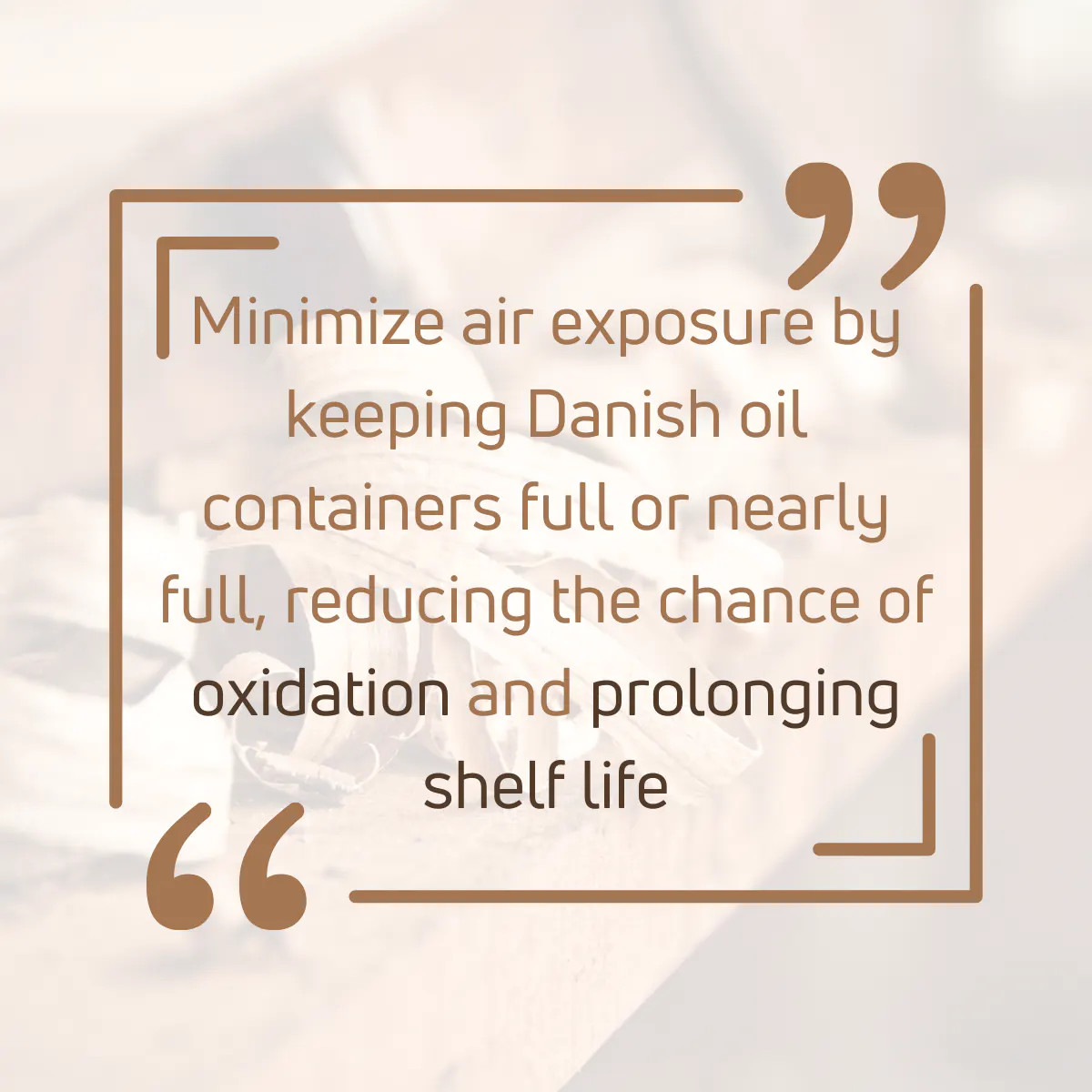
Why Danish Oil Goes Bad
To understand why Danish oil goes bad, it’s essential to grasp its composition.
This blend of linseed oil, tung oil, and mineral spirits might seem like a simple concoction, but the science behind it is fascinating.
Oxygen is Not Always Your Friend
Remember those science classes where we learned about oxidation? Well, here’s where that knowledge comes into play.
Both linseed and tung oil in Danish oil have a tendency to react with oxygen, a process we call polymerization.
This isn’t bad per se, since it’s this very reaction that gives the wood a protective coating.
However, overexposure to oxygen (especially when the can is left open or not sealed properly) can cause the oil to polymerize inside its container.
I recall an instance when I left a can of Danish oil open in my workshop overnight.
By morning, I found a layer of semi-solid film on its surface, a perfect example of how oxygen can be both a boon and a bane!
The Role of Moisture
Another enemy of our beloved Danish oil is moisture. Introducing water to the mix can interfere with the curing process of the oil when applied to wood.
Additionally, moisture can be a gateway for bacteria and mold, making the oil not just ineffective but potentially harmful.
The Effects of Temperature Fluctuations
Heatwaves and Cold Snaps: Just as we humans prefer a comfortable room temperature, Danish oil does too.
Exposure to extreme temperature fluctuations can change the oil’s consistency and efficacy.
I remember keeping a can in the garden shed one winter, thinking it would be safe.
Come spring, the oil had thickened significantly, rendering it almost unusable.
Mixing with Foreign Substances
If you’re someone who’s a bit messy in the workshop (guilty as charged!), you might inadvertently introduce foreign chemicals or particles into the Danish oil can.
Even a slight contamination can affect the oil’s performance and shelf life.
One summer afternoon, I was in a rush and mistakenly used a brush tainted with paint thinner to apply Danish oil.
The results? A streaky, uneven finish that haunted me for weeks!
The Time Factor
As with most natural products, time can diminish the properties of Danish oil.
Even if stored under optimal conditions, the blend of oils and solvents might separate or degrade.
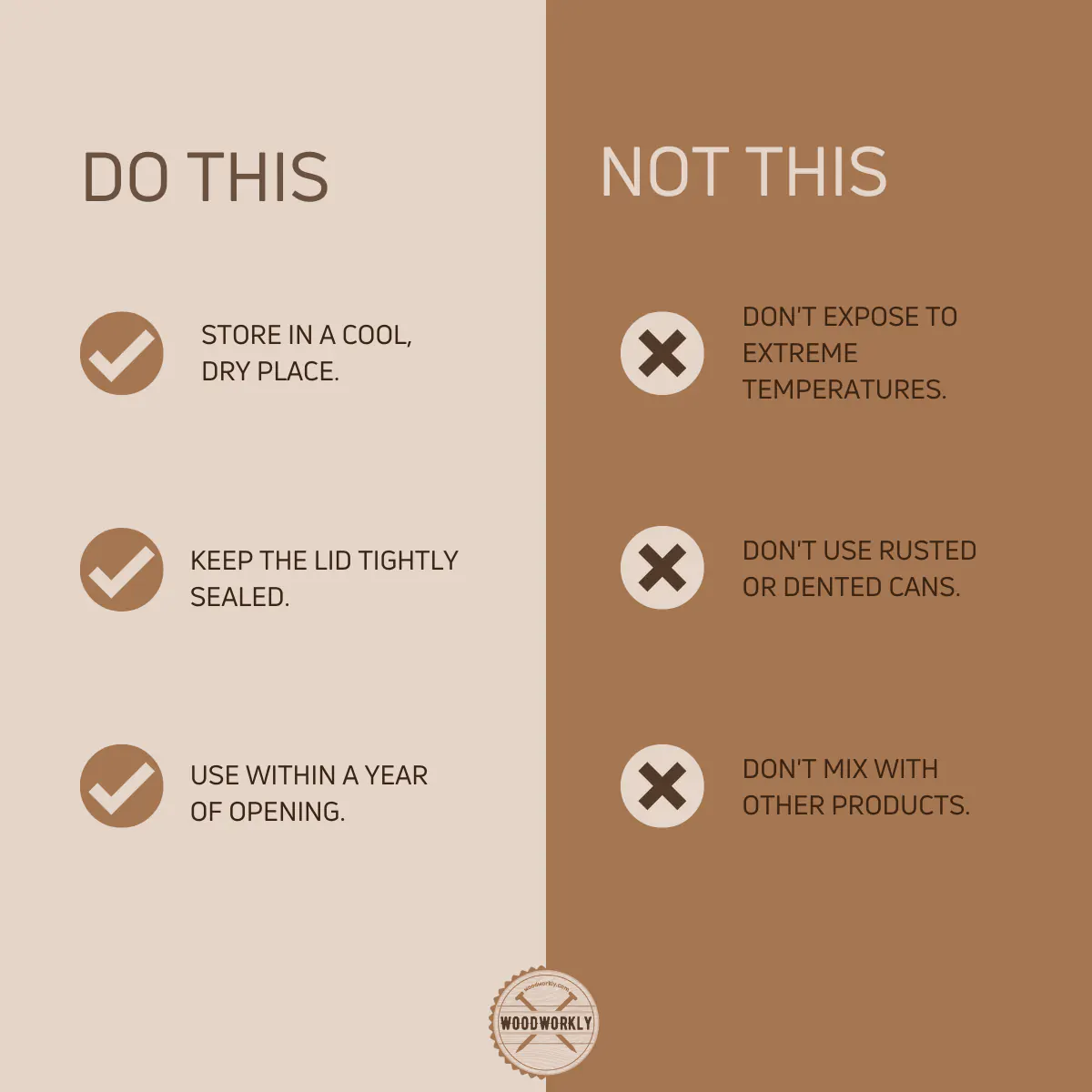
How Can You Tell If Danish Oil Is Bad?
You can tell if Danish oil is bad by its visual appeal. When Danish oil is bad, it will become rubbery, thick, separated, and stringy, unpleasant appearance.
Plus, it develops a characteristic odor that occurs because of rotting or spoiling.
Or you can tell whether Danish oil is bad by testing it with a piece of scrap wood piece and see if dries well.
When Danish oil is contaminated with water, moisture, and other chemical substances, it will lose its qualities, and performance as a finisher reducing its shelf life.
Mold growth is possible when Danish oil is bad. This is common not only for Danish oil but also for some water-based paints.
If there’s nothing wrong with the appearance, here’s a simple test to check whether Danish oil is good or bad to use.
- Take a plastic laminate or glass.
- Add Danish oil to the tip of those surfaces
- Angle it for 45 degrees by allowing Danish oil to flow.
- Then check how long it takes to dry.
If Danish oil dries so well overnight, it is still good to use. If it doesn’t dry within 12 – 24 hours, Danish oil already went bad.
So, as a summary, here are the signs you can tell when Danish oil is bad,
- Does not dry well
- Rubbery, stringy, thick appearance
- Characteristic unpleasant odor
- Oil is rancid
How To Stop Danish Oil from Getting Bad?
If you’ve ever had the misfortune of discovering a tin of Danish oil that’s gone bad (as many of us wood enthusiasts have at one point or another), you’ll know the importance of this topic.
But fear not, fellow crafters, for I have journeyed through the realms of woodworking misadventures and have returned with some tried-and-tested wisdom to share.
Here are the steps you need to follow to stop Danish oil from getting bad,
- Keep Danish oil in a sealed air-free container
- Store Danish oil properly
- Use clean applicators
- Decant properly
- Use Nitrogen spray
Let’s discuss each of the above steps in detail to keep your Danish oil for a long time without any issues.
1. Keep Danish Oil in A Sealed Air-Free Container
Tight Lids are Lifesavers: One of the most straightforward solutions is also the most effective.
Always ensure that the can lid is tightly sealed. It prevents excessive oxygen from entering and stops the oil from oxidizing prematurely.
A little tip from my workshop: After pouring out the oil, I use a piece of plastic wrap over the can before putting the lid back on.
This extra barrier ensures an even tighter seal!
2. Store Danish Oil Properly
Away from Extremes:
Remember the debacle I faced with my garden shed-stored Danish oil? Let that be a lesson!
Store your oil in a cool, dry place away from direct sunlight. Basements or climate-controlled rooms are perfect.
Avoid Moist Environments:
Bathrooms or damp basements? Big no-nos. Moisture is a nemesis we’ve discussed earlier.
Keeping your Danish oil away from damp environments ensures it remains free from mold and bacteria.
3. Use Clean Applicators
Brushes, Rags, and More: Always ensure that the applicators (be it brushes, rags, or anything else) you dip into your can of Danish oil are clean.
This simple habit can prevent contamination, which as we’ve established, can mess with the oil’s composition.
A quick anecdote: I once lent a can to a friend, and it came back with tiny wood shavings in it.
While it made for a good laugh, it also made me extra cautious about the tools I use!
4. Decant Properly
Smaller Containers for Regular Use: If you use Danish oil frequently, consider transferring a portion of it to a smaller container for regular use.
This way, the main can is opened less often, reducing the risk of contamination and oxidation.
Plus, it’s much easier to manage and handle!
5. Use Nitrogen Spray
For those of you who are super keen on prolonging the shelf life of your Danish oil, consider using nitrogen spray.
Spraying a bit into the can before sealing it can displace the oxygen, thus preventing premature oxidation.
It might sound a bit technical, but it’s a trick I picked up from a veteran woodworker, and it’s worked wonders for me!
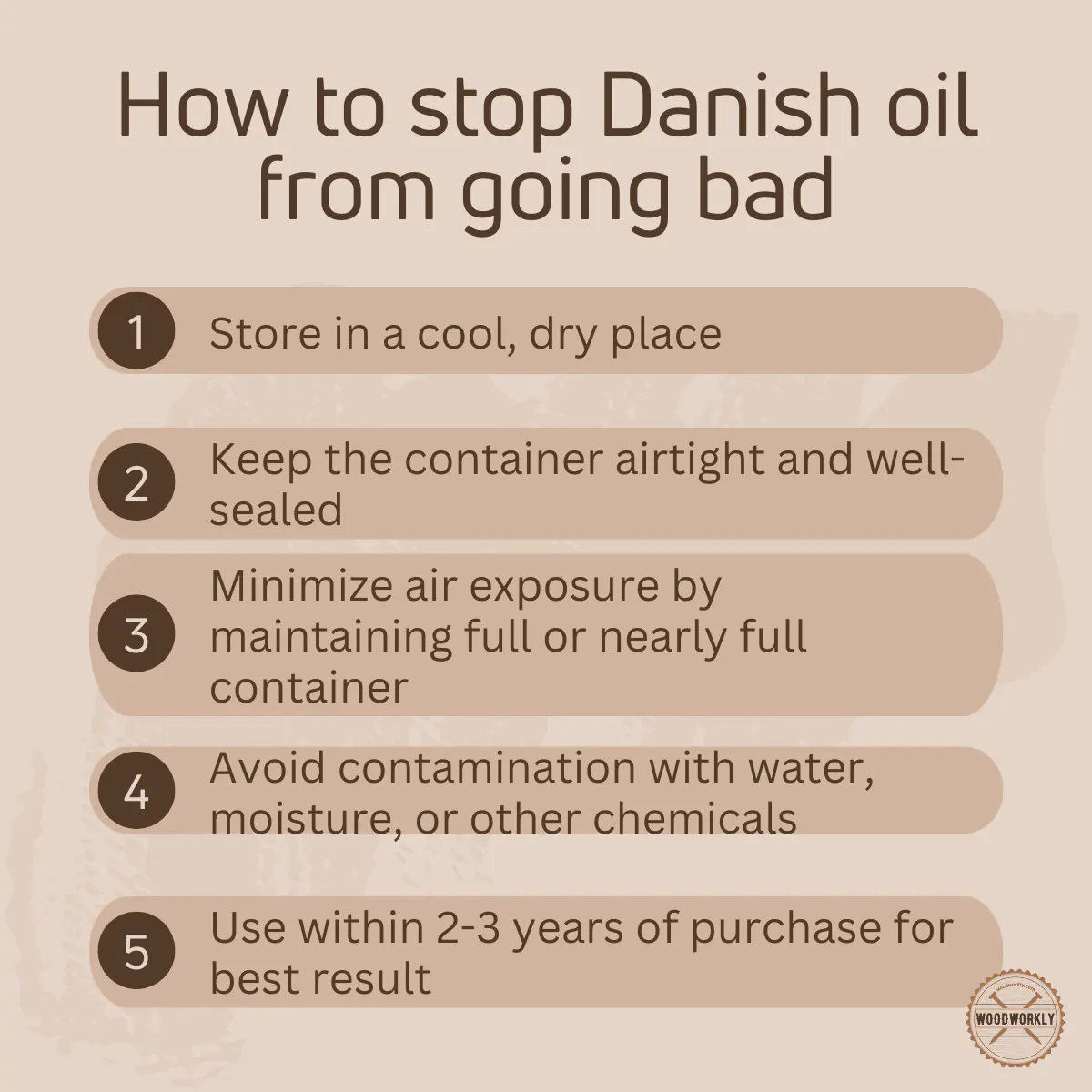
How Long Does Danish Oil Last?
One of the most frequently asked questions in my woodworking circle is: “Just how long can I expect my beloved can of Danish oil to last?”
I mean, we’ve all been there, discovering a long-forgotten can in the back of the cupboard and pondering its usability.
Let’s delve deep into the lifespan of Danish oil and uncover the mysteries of its shelf life, shall we?
Shelf Life Of Unopened Danish Oil
Years on the Shelf: If you’ve managed to resist the urge to open that brand new can of Danish oil, congratulations! In its unopened state, Danish oil can last several years.
Think of it as fine wine, aging gracefully in a cellar, just waiting for its moment to shine (pun intended).
I once stumbled upon a can that had been sitting unopened for about 5 years and guess what? It worked like a charm!
Once the Seal is Broken…
A Year or Two: Generally speaking, once opened, you can expect your Danish oil to retain its best qualities for 1-2 years.
This is provided you store it right. And trust me, I’ve learned this the hard way. I once left an opened can in my sweltering attic, only to discover a gloopy mess a few months later.
How Long Does Danish Oil Last on Wood?
Danish oil lasts on wood for about 1 year or a maximum of 2 years. Reapply Danish oil coating per year to keep Danish oil fresh with all its qualities without making it go bad.
If you keep Danish oil on wood for several years with no maintenance, you’ll probably end up with rotted furniture which will be so hard to fix.
Plus, you cannot fix rotted wood by reapplying Danish oil. Better to use Flex Seal for that.
Factors That Influence Longevity
Storage is Key:
As we’ve reiterated, proper storage can make a world of difference. A cool, dark, and dry environment can be the elixir of life for your Danish oil.
Frequency of Use:
Constantly opening and closing the can introduces more air (and potential contaminants) inside.
Remember the smaller container tip from earlier? It’s golden advice for frequent users.
Seal it Right:
A loosely closed can is a ticket to an early expiration. The tighter the seal, the longer the lifespan.
Personal Tales of the Test of Time
I’ll leave you with this little anecdote: A few years ago, I chanced upon a can of Danish oil that had been with me through countless workshops and relocations.
It was nearing its 2-year mark since being opened. With bated breath, I decided to test it on a small wooden trinket.
To my delight, it worked beautifully, reminding me that with a little care and attention, our crafting materials can indeed stand the test of time.
How Long Does Danish Oil Take To Dry?
Generally, Danish oil takes 2 to 4 hours to dry completely on wood. But this may vary upon environmental humidity and temperature changes.
In highly humid areas, Danish oil may take more than 6 – 8 hours to dry since moisture evaporation from wooden surfaces is too slow.
Even though Danish oil dries within 2 to 4 hours, it takes more than 10 hours to cure properly.
This is why letting drying oil cure through nighttime is recommended.
Once the surface is fully cured, the surface is dry with no stickiness and tackiness.
When applying Danish oil, you can use lint free soft cloth to wipe off the excess which is helpful for fast drying. Excess oil cause blotches and streaks plus makes the surface looks tacky and sticky.
Never apply another coat of Danish oil until the previous one is totally dried.
Proper drying is essential to build up a strong coating with excellent protection from environmental elements like moisture.
Does Danish Oil Cause Mold?
Yes, Danish oil cause mold when it’s too old and bad to use due to the contamination of the oil.
Danish oil is a food source for mold. If the furniture or woodwork is already got affected by mold, it’ll probably get much worse if Danish oil is applied.
Follow the below restoration and cleaning steps to prevent Danish oil from getting mold.
- Clean Danish oil is applied to furniture frequently with a soft dry cloth.
- Place furniture in a sunny area at least once per month to kill mold and mildew.
- Rinse furniture with a garden horse frequently to remove dust and dirt which cause mold.
- Reapply Danish oil by sanding off the previous layer without missing any spots.
As you already know, Danish oil does not have an exact mixing ratio. Therefore, you can make Danish oil by yourself as well.
But I highly recommend you buy Danish oil from a quality manufacturer since they don’t have any contamination issues during production like homemade ones.
Why Does Danish Oil Go Sticky?
Danish oil goes sticky when it is bad, too old and when it didn’t dry well. To prevent the stickiness of Danish oil use a fresh, thin coat of Danish oil and let it dry properly between coats.
Plus, wipe off the excess between coats.
Here’re the steps you need to follow to fix sticky Danish oil,
- Take lint free soft cloth and soak it in mineral spirits.
- Wipe it over the whole surface in circular motions.
- Soak the cloth continuously and wipe the surface until tacky areas got removed.
- After removing the sticky areas, buff the wooden surface.
- Let it dry completely.
If Danish oil is still sticky after following the above method, we can come to the conclusion that Danish oil is too old it went bad by losing its fast-drying properties.
So, better to replace the Danish oil with a new one and reapply Danish oil after sanding the previous sticky Danish oil coatings.
Wipe off excess Danish oil during the application process for fast drying.
Let the new Danish oil coat dry and cure properly for 24 hours and see how it dries quickly without leaving a sticky surface.
Problem That Occurs When Danish Oil Go Bad with Solutions
Here is some common issue that occurs when Danish oil goes bad. Let’s see what is it and how we can solve the issue.
1. Danish Oil is Uneven
Uneven shiny spots occur when Danish oil is rancid or when the oil is contaminated because of moisture.
Danish oil reacts with atmospheric oxygen and starts oxidation and radical formation which will eventually lead to an uneven surface.
Solution:
Remove previously applied Danish oil layers with mineral spirits and sand the surface.
Then apply the new Danish oil product except the old one. Make sure to keep the new Danish oil can in a cool, dry place with properly sealed.
So, let’s answer some frequently asked questions.
FAQs
How can I tell if my Danish oil has gone bad?
If your Danish oil has a rancid smell, appears thick and gloopy, or shows signs of mold, it’s time to part ways with it.
Does unopened Danish oil last longer?
Absolutely! An unopened can of Danish oil can gracefully age and remain effective for several years when stored in a cool, dark place.
Can frequent use reduce the shelf life of Danish oil?
Yes, frequently opening and closing the can introduces air, which can reduce its shelf life. If you’re a regular user, consider transferring the oil to smaller containers.
Can I revive old or thickened Danish oil?
While it’s tempting to try and save a beloved can, once Danish oil has thickened or changed in consistency, it’s challenging to restore its original properties.
How should I dispose of expired Danish oil?
Don’t just toss it in the trash! Check local regulations for proper disposal methods or drop it off at a hazardous waste facility.
Can I mix old and new Danish oil?
While it’s technically possible, mixing old with new may not yield the best results. For a consistent finish, it’s advisable to use fresh Danish oil.
How do I extend the shelf life of my opened Danish oil?
Store it in a cool, dark place, ensure the lid is tightly sealed, and if possible, transfer the oil to smaller containers to reduce air exposure.
Did I cover all you wanted to know about: Does Danish Oil Go Bad?
In this article, I have deeply discussed does Danish oil go bad and how can we stop Danish oil from going bad and maintain it properly to increase its shelf life.
Danish oil goes bad when it is not stored properly. Danish oil has a shelf life of two to three years or more when it is stored in a tightly closed, full, or nearly full container in a cool dry place. When Danish oil is not stored well, it will contaminate due to water, and other chemical substances and go bad easily.
Furthermore, I’ve answered some frequently asked questions as well.
Hope you have gained good knowledge about how to prevent Danish oil from going bad and what necessary steps need to take.
Try your next wood finishing project with Danish oil and make sure to keep it safe to save your money and time. happy woodworking!